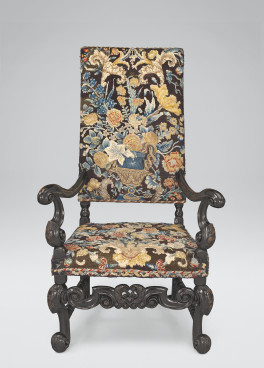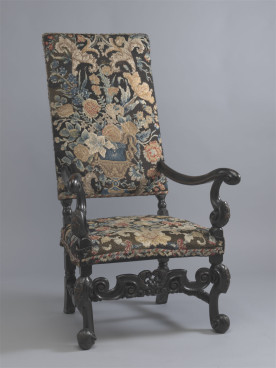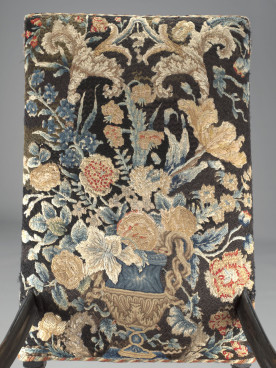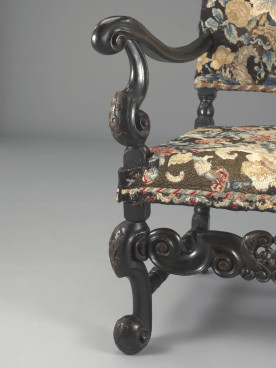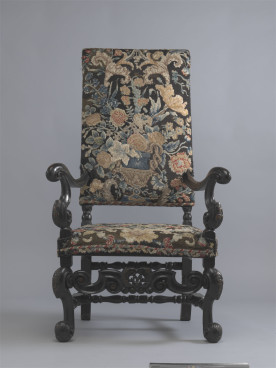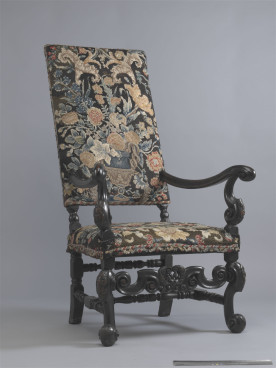Armchair, c.1702
Japanned beech with original needlework
This chair is one from a larger set made for the state bedchamber at Drayton House, Northamptonshire, during the time of Lady Mary Mordaunt (1659–1705), 7th Baroness Mordaunt. The embroidery was supplied by Rebecca Dufee and Elizabeth Rickson. The seat rail block bears a partial label of Phillips of Hitchin.
Victor Chinnery Catalogue
Description
An ebonised beech upholstered armchair, the high rectangular back flanked by scrolling outcurved arms supported on turned balusters to the rear and corner horsebone scrolls to the front, the scrolls enriched with raised leafy carving, the seat raised on corner horsebone scrolled front legs flanking a pierced and scroll-carved fore-stretcher, the rear legs part-turned and with great heels extended to the rear, the legs united by baluster-turned H-stretchers, the frame ebonised; the back covered with rich polychrome floral needlework embroidery in wool and silk, the seat provided with conforming slip-case.
Dimensions
W: 28½in. Ht: 49½in. D: 29½in.
Condition
Correct authentication of old timber/paint surfaces is difficult, since the ebonised surfaces have been extensively refreshed. Though the chair is undoubtedly genuine, there is evidence of considerable 19th century and modern restoration to the frame.
A superficial inspection suggests the following areas of restoration (the frame covered by upholstery not seen):
(Observer’s left and right) the left arm, left arm support and seat-rail block, right arm support and seat-rail block, right leg knee carving, H-stretcher (with the exception of the right front turned section) all appear to be new.
The right rear upright has old upholstery damage at seat level, but this and the lower section are possibly 19th century repairs.
The left rear upright has upholstery damage at seat level, but this is not convincing, suggesting that left rear upright is new.
The seat-rails appear old, though with later corner blocks for strengthening.
References
From the State Bedroom at Drayton House, Northamptonshire, one of a set of eighteen chairs made en suite with the State bed and supplied in 1701/2 to Lady Mary Mordaunt (d.1705) daughter of Henry, 2nd Earl of Peterborough, widow of Henry, 7th Duke of Norfolk (d.1705) and wife of Sir John Germain Bt. (d.1718). Twelve similar chairs and a slightly different settee survive together with the bed at Drayton House, six chairs having been sold in 1928.
The original accounts for the bed and chairs are discussed by Geoffrey Beard in Upholsterers and Interior Furnishing in England 1530-1840, Yale University Press 1997, pp. 134-8, Figs. 111-12. See also B A Bailey, Drayton House, Northamptonshire (guide book 1990); and N U Stopford-Sackville, Drayton House, Northamptonshire, privately published 1939.
One chair (still at Drayton) is illustrated by Adam Bowett in English Furniture 1660-1714, p. 238, Plate 8:17.
Another chair from the set is in the collection of the Victoria & Albert Museum, London (Acc. No. W.34-1950; see R Edwards, English Chairs, V&A Large Picture Book No. 10, HMSO 1970 (3rd ed.), No. 31; also illustrated by Peter Thornton in Seventeenth Century Interior Decoration in England, France & Holland, p. 205, Fig. 192).
A pair of identical chairs from the same source were exhibited in the Loan Exhibition depicting the Reign of Charles II at 22/23 Grosvenor Place, London, 1932, Cat. No. 340, one illustrated on p. 43, where they are recorded as the property of Nigel Stopford-Sackville Esq. (see copy of catalogue on deposit in Bryan Archive).
Comments
The ‘corner horsebone’ pattern of the front legs evolved in the 1690s and was at its zenith around 1700.
Baroque
Provenance
Purchased Nicholas Grindley, 20 January 1997.

